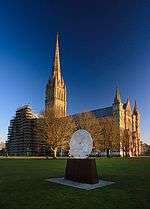Emily Young
Emily Young FRBS (born 1951) is a sculptor,[1] who has been called "Britain's greatest living stone sculptor".[2] She was born in London into a family of artists, writers and politicians. She currently divides her time between studios in London and Italy.[3]

Biography
Her mother was the writer and commentator Elizabeth Young, her father, Wayland Hilton Young, 2nd Baron Kennet, a politician, conservationist and writer.[4] Emily Young's paternal grandparents were the politician and writer Edward Hilton Young, 1st Baron Kennet and the sculptor Kathleen Scott, a colleague of Auguste Rodin and the widow of the polar explorer Robert Falcon Scott. Her uncle was the ornithologist, conservationist and painter, Sir Peter Scott, who founded the Wildfowl & Wetlands Trust.
Emily Young received her secondary education at Putney High School, Holland Park School, Friends School Saffron Walden and the King Alfred School, London. First interested in painting, she spent her youth in London, Wiltshire and Italy before she attended the Chelsea School of Art for one term in 1968 and also studied at Saint Martin's School of Art. In the late 1960s and 1970s, she travelled widely, visiting Afghanistan, Pakistan, India, France and Italy, Africa and the Middle East (see Hippie trail). She lived in the United States, where she studied with the sculptor Robert White.
While at Holland Park School in 1966, she became a regular at the nearby London Free School night sessions in the Notting Hill area, which brought her into contact with many in the UK Underground.[5] She may have been the inspiration for the song "See Emily Play", written by Pink Floyd's Syd Barrett.[4][6][7]
During the 1970s and 1980s, she lived and worked with Simon Jeffes, proprietor of the Penguin Cafe Orchestra and had one son, Arthur, born in 1978. She produced the artwork for various album covers for the orchestra, including Music from the Penguin Cafe.
Work
Young's sculpture is held in many public as well as private collections. Some of her permanent installations can be seen in St. Paul's Churchyard and Salisbury Cathedral.[8] Young's Lunar Disc 1 was installed at Loyola University Chicago in 2011.[9]
References
- artnet. "Emily Young". Retrieved 2007-02-22.
- Wullschlager, Jackie (2013-09-01). "Emily Young, We Are Stone's Children, Fine Art Society, London – review". Financial Times. Retrieved 2014-01-06.
- Young, Emily. "Emily Young Sculpture". Retrieved 18 May 2020.
- Chapman, Rob (2010). "Flicker Flicker Blam Blam Pow". Syd Barrett: A Very Irregular Head (Paperback ed.). London: Faber. pp. 93–94. ISBN 978-0-571-23855-2.
- Barry Miles (2010), London Calling: A Countercultural History of London since 1945, p. 188.
- Chapman, Rob (2010). "Distorted View – See Through Baby Blue". Syd Barrett: A Very Irregular Head (Paperback ed.). London: Faber. p. 161.
- Tobin, Emily. "Sculptor Emily Young's Tuscan Monastery". House & Garden. Retrieved 2018-12-17.
- ""Emily Young – Sculptor", BBC Woman's Hour Arts Archive, 25 May 2007". Archived from the original on 18 December 2018. Retrieved 2 August 2013.
- "Where Did All of the Sculptures Come From?". Loyola Phoenix. 2015-04-23. Retrieved 2018-03-23.